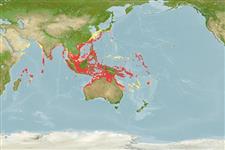Common names from other countries
>
Eupercaria/misc (Various families in series Eupercaria) >
Lutjanidae (Snappers) > Lutjaninae
Etymology: Lutjanus: Malay, ikan lutjan, name of a fish.
More on authors: Quoy & Gaimard.
Environment: milieu / climate zone / depth range / distribution range
Ecologie
marien; brak water rifbewoner; diepte 10 - 72 m (Ref. 9710). Tropical; 35°N - 26°S, 50°E - 180°E (Ref. 55)
Indo-West Pacific: Seychelles, then southern India to New Caledonia and Gilbert Islands, extending northward to the Ryukyu Islands Replaced by Lutjanus ophuysenii from southeastern China and Taiwan to southern Korea and Japan (Ref. 37816).
Lengte bij maturiteit / Grootte / Gewicht / Leeftijd
Maturity: Lm 15.4, range 14 - 22 cm
Max length : 40.0 cm TL mannelijk / geslacht onbekend; (Ref. 55); common length : 35.0 cm TL mannelijk / geslacht onbekend; (Ref. 5450); max. gerapporteerde leeftijd: 12 Jaren (Ref. 37970)
Dorsale stekels (totaal): 10; Dorsale zachte stralen (totaal): 12-14; Anale stekels 3; Anale zachte stralen: 8 - 9. Dorsal profile of head moderately sloped. Preorbital width about equal to eye diameter. Preopercular notch and knob poorly developed. Scale rows on back rising obliquely above lateral line. Generally whitish or pink with a yellowish brown to black stripe on the middle of the side. Juveniles and sub-adults with an intensely black mid-lateral stripe and an oval black spot, eye-sized or greater, lying in the middle of the stripe below last dorsal spines. Adults with yellow median fins (Ref. 48635). Body depth 2.6-3.0 in SL (Ref. 90102).
Adults are found in the vicinity of coral reefs, also areas with flat bottoms and occasional low coral outcrops, sponges, and sea whips. They occur singly or in groups of up to about 30 individuals. Feed on fishes, shrimps, crabs and other benthic invertebrates.
Sex ratio differed significantly from 1:1 above 30 cm fork length (Ref. 4840). Larvae grow at a rate of 1.2 to 1.7 mm per day during the first 1 or 2 months.
Allen, G.R., 1985. FAO Species Catalogue. Vol. 6. Snappers of the world. An annotated and illustrated catalogue of lutjanid species known to date. FAO Fish. Synop. 125(6):208 p. Rome: FAO. (Ref. 55)
Status op de Rode Lijst van het IUCN (Ref. 130435)
CITES (Ref. 128078)
Not Evaluated
Gevaar voor de mens
Harmless
Gebruik door de mens
Visserij: commercieel; Aquarium: Publieke aquaria
Tools
Speciale rapporten
Download XML
Internetbronnen
Estimates based on models
Preferred temperature (Ref.
115969): 25.1 - 29.1, mean 28.2 (based on 1040 cells).
Fylogenetische diversiteitsindex (Ref.
82804): PD
50 = 0.5000 [Uniqueness, from 0.5 = low to 2.0 = high].
Bayesian length-weight: a=0.01479 (0.01292 - 0.01693), b=2.97 (2.94 - 3.00), in cm Total Length, based on LWR estimates for this species (Ref.
93245).
Trofisch niveau (Ref.
69278): 4.0 ±0.3 se; based on diet studies.
Weerstandsvermogen (Ref.
120179): Gemiddeld, minimale populatieverdubbelingstijd 1,4-4,4 jaar (K=0.22-0.70; tmax=12).
Fishing Vulnerability (Ref.
59153): Low vulnerability (23 of 100).
